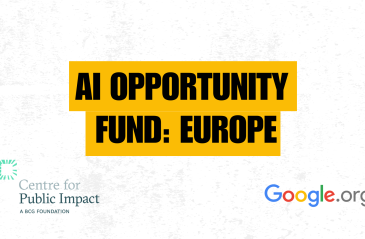
10 things we’ve learned and believe in after delivering 5 years of Public Sector Design Training

From Aussie gov depts, to Norwegian design companies; the Public Impact Starter Kit had global reach. What does this mean for CPI's work?
Share article@MDaliChaouch & @gracecarmella3 helped with the Public Impact Starter Kit campaign & reflect on what it has taught CPI about policymaking.
Share articleThe PIF has been a major focus for CPI for years, and its impact continues to grow. How has a tactile starter kit helped changemakers?
Share articleWe put our vision for government into practice through learning partner projects that align with our values and help reimagine government so that it works for everyone.
Nearly 100 policymakers, 19 countries, and 6 weeks: these are the numbers behind our Public Impact Starter Kit campaign.
We sent the kit to countries ranging from Botswana to Germany and from Singapore to Switzerland, a global reach enabling us to find out how policymakers across the globe used the kit to support their work.
Now that the campaign has come to an end, we wanted to reflect on the five things we learned about the Public Impact Fundamentals (PIF):
In talking to policymakers who applied the PIF in a number of unique contexts, we discovered success with governments like Jersey and the Isle of Man. These can be described as ‘policy laboratories' of sorts; their ability to work closely with residents and stakeholders aligns with the PIF's emphasis on stakeholder engagement, enabling those most impacted by policies to contribute to the process and ensure well-roundedness.
For example, we spoke to Mark MacGregor, a Policy Principle in the Government of Jersey. He mentioned how his team of around 40-50 people were a “small team for sharing a learning together”. With the help of the PIF, this characteristic enabled them to experiment with closer and more direct stakeholder engagement.
Mark and his team used the kit to help plan a policy on financial dependence in old age, focusing on how the government could encourage retirement savings. Specifically, he describes that kit as
A useful way of looking strategically and saying who my stakeholders need to be.
This echoes the experiences of Dan Davies, the Chief Officer at the Isle of Man Government. The PIF helped him to uncover the large number of different stakeholders involved in their project on a sexual offences bill, which ranged from “young people who might not understand why homosexuality was ever an issue”, to “more conservative groups who had memories of a completely different era”.
On the other hand, the kit has also seen huge uptake from large national governments across the world.
Most notably, we sent 24 kits to various Australian government departments, including the Department of Employment, Skills, Small and Family Business, and the Department of Industry. Specifically, the National Indigenous Australians Agency applied the kit to their policies supporting the aborigional population, who are overrepresented amongst job seekers, to find work.
Similar interest was found in Canadian, British and American governments, amongst many others; demonstrating the diversity of the PIF and its users. This shows global desire to have well-rounded and engaging policies that cover the three areas of Legitimacy, Policy and Action.
Early in the campaign we spoke to Arthur Wittenburg, who leads the Department of Federal Affairs in the Brasilia Government. He told us about how the kit can have leverage with politicians, using the PIF to
Construct arguments to influence the policies that congressmen are trying to pass. [This] helps a congressman to approve or prevent [a policy] from advancing.
This shows how the PIF can visually highlight the strengths and weaknesses of a policy; continuing to inform the process even after a policy has been crafted. Arthur's application of the PIF in the planning process to evaluate policies continues to demonstrate the versatility of its use.
A major takeaway from our discussions was the different ways those in government used the kit. While some saw it as more of a planning tool, others used it as a reflective tool in intervals throughout the policymaking process.
Mark MacGregor described how the tool helped to keep his policy process in check, suggesting that
It can be used to hold policy makers to account. Having quality control checks and reviews embedded into the policy process is important and it allows for that.
In this case, the PIF ensured that all the different aspects needed for policy success were maintained.
Meanwhile, Arthur Wittenburg suggested that the kit was most crucial in the planning stage, allowing him to design a policy and action plan centred around the three key areas that “provided revelations on hidden issues”. This enabled incorporation of ‘Legitimacy'; a topic often overlooked in general policy formulation.
Hence, the PIF has evidently been seen as a guiding prompt that offers a starting point when thinking about policies. How this helps policymakers becomes dependent on how they see it fitting into their specific work.
In many of our conversations, the tactile nature of the kit was complemented by changemakers, who felt that policymaking can be intensely drawn out and complicated. So, having a simple tool that visually plots successes and failures has proven helpful in rationalising complex processes. One policymaker in the UK government describes how an “attractive physical prop really does encourage people to use it.”
This was echoed by Adrian Paulsen and Kjersti Holhjem from the Norwegian policy & design company Halogen, whose unique perspectives combine policy and design expertise. They pointed out that in modern policymaking procedures, and in their own experience using the kit, it is its visually compelling nature that makes it appealing to pick up and use.
Halogen using the kit to develop new wayfinding systems for bicycle trails
In the past couple of years, the PIF has been an important focus for CPI. We have successfully applied this framework with changemakers all over the world, helping to inform well-rounded policies and policy debates. After much discussion about the future of the PIF, we have concluded that it remains an integral part of our services, alongside other areas of focus such as how governments can become more legitimate, or how they can fail forward.
Hence, we would love to keep circulating the remaining kits we have left, and continue hearing about how the kit is being used.











